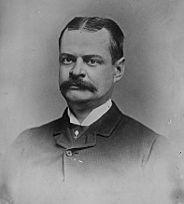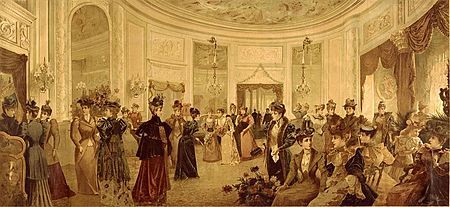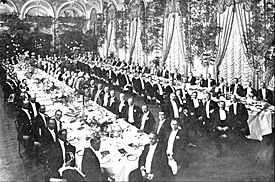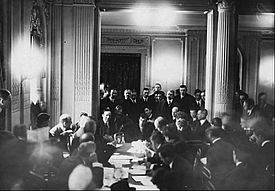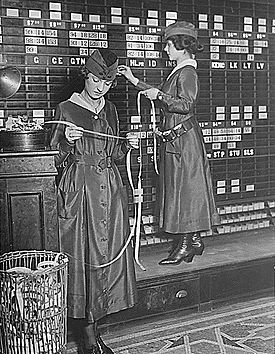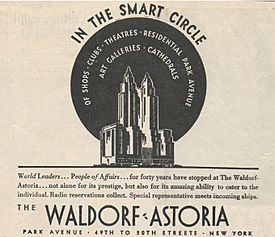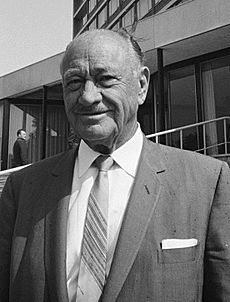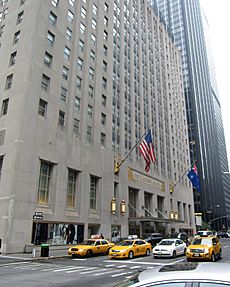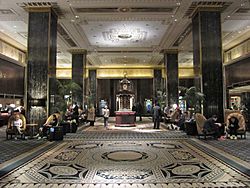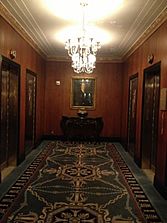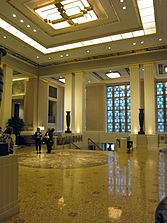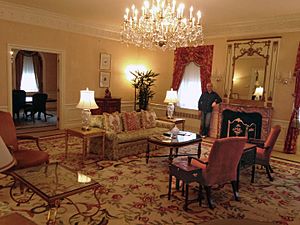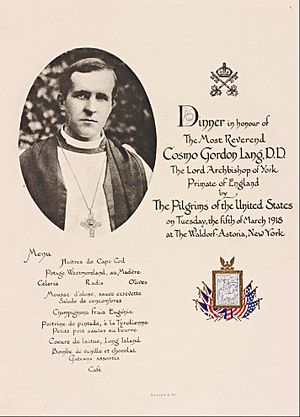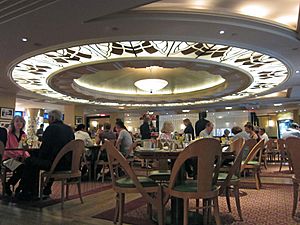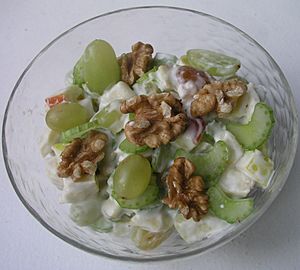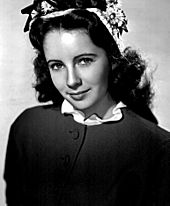Waldorf Astoria New York facts for kids
| Waldorf Astoria New York | |
Quick facts for kids 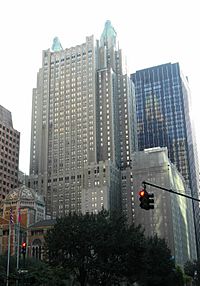 The hotel from the north, with St. Bart's visible in the foreground. |
|
| Hotel facts and statistics | |
|---|---|
| Location | 301 Park Avenue Manhattan, New York City |
| Coordinates | 40°45′23″N 73°58′27″W / 40.75639°N 73.97417°W |
| Closing date | 2017 (temporarily for renovations) |
| Architect | Schultze & Weaver |
| Management | Hilton Worldwide |
| Owner | Anbang Insurance Group |
| No. of restaurants | Peacock Alley Bull and Bear Steakhouse La Chine |
| No. of rooms | 1,413 |
| No. of floors | 47 |
The Waldorf Astoria New York is a very fancy hotel in Midtown Manhattan, New York City. This amazing building is located at 301 Park Avenue. It stands between 49th and 50th streets. The hotel is 47 stories tall, reaching 625 ft (191 m) into the sky. It was designed in the Art Deco style by architects Schultze and Weaver and finished in 1931.
From 1931 to 1963, the Waldorf Astoria was the tallest hotel in the world. It was then passed by the Hotel Ukraina in Moscow. The Waldorf Astoria is known for its glamour and luxury. It is one of the most famous hotels globally. Both the outside and inside of the Waldorf Astoria are protected as official landmarks by the New York City Landmarks Preservation Commission.
The first Waldorf–Astoria hotel was built in two parts. It was originally the Waldorf Hotel and the Astoria Hotel. This is why it has a double name. That first hotel was on Fifth Avenue and opened in 1893. It was torn down in 1929 to make space for the Empire State Building.
After moving to its new location, the Waldorf Astoria became famous worldwide. It hosted many grand dinner parties and events. These often involved important political and business meetings. Many rich and famous people attended. After World War II, it played a big part in world events. Conrad Hilton took over managing the hotel in 1949. His company, Hilton Hotels Corporation, bought it in 1972.
The hotel had a big renovation in the 1980s and early 1990s. In 2014, a Chinese company, Anbang Insurance Group, bought the hotel. It was the most expensive hotel ever sold at that time. In 2016, Anbang announced plans to change some hotel rooms into apartments. The hotel closed in 2017 for a three-year renovation. The new building will have 375 hotel rooms and 375 new apartments.
The Waldorf Astoria and Towers has 1,413 hotel rooms. Many luxury suites are named after famous people who stayed there. These include the Cole Porter Suite and the Winston Churchill Suite. The most expensive room is the Presidential Suite. It looks like the White House. Former President Herbert Hoover lived there for over 30 years. Frank Sinatra also had a suite there. The hotel has three main restaurants: Peacock Alley, The Bull and Bear Steak House, and La Chine.
What's in a Name?
The hotel's name comes from the town of Walldorf in Germany. This town is the original home of the Astor family. They were a very important German-American family. In German, "Waldorf" means "Whale Village." The town's name, "Walldorf," means "Rampart Village." But it actually came from "Walddorf," meaning "Forest Village."
The hotel was first called the Waldorf-Astoria with one hyphen. People even had a saying, "Meet Me at the Hyphen." When Conrad Hilton bought the hotel in 1949, he changed it to a double hyphen. This looked like an equals sign. The double hyphen was meant to represent "Peacock Alley." This was a hallway that connected the two original hotels. The double hyphen was stopped in 2009. Now, the hotel is called the Waldorf Astoria New York, without any hyphen.
Hotel History
The First Buildings
The first hotel started as two separate hotels. They were built by family members who had disagreements. The first part, the Waldorf Hotel, opened in 1893. It was 13 stories tall and had 450 rooms. It was built on Fifth Avenue where William Waldorf Astor had his mansion.
William Astor built the Waldorf Hotel next to his aunt's house. This was partly because of a family disagreement. The hotel was built for George Boldt, who owned and ran another hotel in Philadelphia. Boldt was described as a quiet and humble man.
At first, people thought the Waldorf would fail. It had many bathrooms, which was unusual then. People called it "Boldt's Folly" or "Astor's Folly." Wealthy New Yorkers were upset. They thought the hotel ruined the neighborhood. Business travelers found it too expensive. To help, George Boldt held a charity concert on opening day. Many important New York families attended. They paid five dollars for the concert and dinner. The hotel quickly became a huge success. It earned $4.5 million in its first year.
William Astor's hotel made his family disagreements worse. But with Boldt's help, William's cousin, John Jacob Astor IV, convinced his mother to move. In 1897, John Jacob Astor IV opened the 17-story Astoria Hotel next door. He leased it to Boldt. The hotels were separate at first. But Boldt designed the Astoria so it could connect to the Waldorf. "Peacock Alley" was built to connect them. The hotel then became known as the "Waldorf-Astoria." It was the largest hotel in the world at that time.
Its Golden Age
The hotel had a telephone in every room. It also offered excellent room service. It was made to serve the wealthy people of New York. It also welcomed important visitors from other countries. The Waldorf-Astoria became a symbol of the Astor family's wealth. It was the first hotel to have full electricity and private bathrooms.
George Boldt, the owner, became very rich. His motto was "the guest is always right." He was not as famous as his employee, Oscar Tschirky. Oscar was the maître d'hôtel (head waiter) from 1893 until 1943. He was known as "Oscar of the Waldorf." Oscar came from Switzerland. He knew a lot about cooking. He wrote The Cookbook by Oscar of the Waldorf (1896). This book had 900 pages of popular recipes. He created famous dishes like Waldorf salad, eggs Benedict, and Thousand Island dressing. These are still popular today.
The Waldorf became famous for its charity dinners and balls. Important people like Andrew Carnegie often attended. Banquets were held for famous figures and royalty. The Waldorf Astoria also helped women gain status. Women were allowed to enter alone without male escorts. George Boldt's wife, Louise Kehrer Boldt, helped make the hotel a social center for women.
In 1899, Oscar hosted a very expensive dinner. It cost $250 per guest. This was a lot of money back then. In 1902, a grand dinner was held for Prince Henry of Prussia. In 1909, banquets were held for hundreds of guests. These included Arctic explorer Frederick Cook.
The U.S. Senate investigation into the sinking of the RMS Titanic started at the hotel in 1912. It took place in the Myrtle Room. John Jacob Astor IV was one of the people who died on the Titanic.
In 1919, famous restaurateur Louis Sherry teamed up with the Waldorf-Astoria. He offered his candies and catering services. In 1926, the National Broadcasting Company (NBC) started its first radio program from the hotel's ballroom. Famous entertainers like Will Rogers were heard.
By the 1920s, the hotel was getting old. New York's social life had moved further uptown. The Astor family sold the hotel to the developers of the Empire State Building. The hotel closed on May 3, 1929, and was soon torn down.
The Current Building
Early Years and World Events
The idea for a new Waldorf-Astoria hotel was to create a grand hotel for important visitors. It was easy to get money for the new hotel in 1929. But then the stock market crashed, and the Great Depression began. Some investors worried about building a luxury hotel. However, they decided to go ahead with the project.
The new building opened on Park Avenue on October 1, 1931. It covered an entire city block. It was the tallest and largest hotel in the world at the time. The tall central part became known as the Waldorf Towers. It had its own private entrance. President Herbert Hoover spoke on the radio from the White House for its opening. He called it "an exhibition of courage and confidence." But on opening day, the 2,200-room hotel had only 500 guests. The hotel didn't make a profit until 1939.
Like the first hotel, the new Waldorf Astoria became famous for its glamorous parties. It hosted many political and business meetings. Author Ward Morehouse III called it "comparable to great national institutions." In 1932, 200 people from New York's literary world honored Pearl S. Buck. She wrote The Good Earth. During the 1930s and 1940s, guests enjoyed music at the "Starlight Roof" nightclub.
The hotel played a big part in international relations after World War II. Many events and conferences were held there. In 1946, Winston Churchill attended a dinner at the hotel. From November to December 1946, the Big Four Conference was held there. Leaders from the United States, Britain, France, and the Soviet Union met. They discussed the future of Eastern Europe. In 1947, Hollywood film leaders met at the Waldorf Astoria. They created the Waldorf Statement. This statement banned people with Communist beliefs from the film industry.
In 1948, the LP record was introduced at a press conference at the hotel. In 1949, a conference for world peace was held there. It discussed the growing differences between the US and the Soviet Union. Many people attended, including Soviet Foreign Minister Andrey Vyshinsky. In 1954, an Israeli archaeologist secretly met with an Archbishop in the hotel's basement. They bought four Dead Sea scrolls.
April in Paris Ball
The April in Paris Ball was a yearly fancy event. Its goal was to improve relations between France and the United States. It also shared cultures and helped charities. The hotel's banquet manager, Claude Philippe, started it in 1952. Socialites helped organize the details. Elsa Maxwell was a key organizer.
The ball was first held in April. Later, it moved to October. This was because many other balls happened in the spring. The ball was for "very, very high-class people." Raffle tickets cost US$100 per person. They offered amazing prizes like expensive jewelry, furs, and cars. Guests always went home with at least one gift. Over the years, the ball raised millions of dollars for charities. Most of the money went to American charities.
The Paris Ball became a very important event. It featured elaborate shows. French stars like Juliette Gréco and Jean Sablon performed. The 1957 event had 1300 guests. These included the Duke and Duchess of Windsor, Senator John F. Kennedy, and Marilyn Monroe. They each paid $100. The final ball at the hotel was in 1959. It had a Parisian circus theme. Marlene Dietrich performed two songs.
Recent History
On May 6, 1963, Time magazine celebrated its 40th anniversary at the hotel. About 1500 celebrities attended. These included General Douglas MacArthur and Bob Hope. In 1968, the British rock band The Who stayed at the hotel. They were known for being rowdy. The hotel asked them to pay cash upfront. After a concert, they were refused access to their rooms. The band was reportedly banned from the hotel for life. However, they later performed there in 1990.
Soon after the hotel opened in 1931, hotel owner Conrad Hilton was almost bankrupt. He reportedly cut out a picture of the hotel from a magazine. He wrote "The Greatest of Them All" across it. He took over managing the hotel in 1949. His company finally bought the hotel in 1972.
In the 1970s, the Waldorf Astoria continued to be important in world politics. This was especially true for relations between the US and the Middle East. In 1974, a Palestinian leader, Farouk Kaddoumi, stayed at the hotel. Security was very tight. In 1975, Yasser Arafat, a PLO leader, also stayed there. Security was increased even more.
In 1981, IBM introduced its Personal Computer at a press conference at the Waldorf Astoria. In 1985, the NBA held its first-ever draft lottery there. This was for the 1985 NBA Draft.
Lee Jablin led a $150 million renovation of the hotel in the 1980s and 1990s. The hotel was named an official New York City Landmark in 1993. In 2006, Hilton started the Waldorf Astoria Hotels & Resorts brand. This brand is named after the hotel. Now, there are Waldorf Astoria hotels in many places around the world.
In October 2014, the Anbang Insurance Group from China bought the Waldorf Astoria New York. It cost US$1.95 billion. This made it the most expensive hotel ever sold. In 2016, Anbang announced plans to renovate the hotel. They would turn some rooms into condominiums. The hotel closed on March 1, 2017, for this renovation. Its restaurants also closed. In 2017, the New York City Landmarks Preservation Commission voted to protect the hotel's famous public spaces. This means they cannot be changed during renovations. In 2019, it was announced that the new apartments would go on sale in 2020. The hotel rooms are expected to reopen in 2021.
Hotel Design
Travel America magazine said that being in the Waldorf-Astoria is like stepping back in time. It reminds you of the glamorous 1930s. Back then, it was the tallest hotel in the world. It was also the center of high society. This famous limestone building takes up a whole block in Midtown Manhattan. It is still a very important address.
Outside the Hotel
The hotel was designed by Schultze and Weaver. It was built at 301 Park Avenue. This is just north of Grand Central Terminal. The area was built over existing railroad tracks. The new building opened on October 1, 1931. The 47-story hotel was 190.5 m (625 ft) tall. It was the tallest and largest hotel in the world for many years.
A lot of expensive materials were used. This included black marble from Belgium and other stones from Italy. About 300 old fireplaces were brought in. Two hundred train cars brought limestone for the outside. They also brought steel for the building's frame. The towers are covered in brick.
Peacock Alley is a long corridor inside the hotel. It is lined with amber marble. In the past, women would walk along it and admire themselves. The Peacock Alley restaurant in the current hotel is named after this famous hallway.
Inside the Hotel
The hotel has a rich history and beautiful design. Tours are given for guests to see it. Frommer's travel guide calls it an "icon of luxury." They point out the wide hallways and old-style door fixtures. They also mention the white-gloved bellmen and fancy shops. The main lobby has a stunning round mosaic. It is under a huge crystal chandelier. There is also a famous Waldorf clock. It has bronze figures on it. The rooms are decorated like an English country house.
The lobby floor has the check-in desks. It also has the Empire Room and Hilton Room. There is the private Marco Polo Club and the Wedding Salon. You can also find Kenneth's Salon, the Peacock Alley lounge and restaurant, and Sir Harry's Bar. From 1992 to 2013, Kenneth, a famous hairdresser, had his salon here. He was known for creating Jacqueline Kennedy's hairstyle.
In the main foyer, there is a huge chandelier. It is 10 feet (3.0 m) by 10 feet (3.0 m). The elevators are made of beautiful wood. Special desks in the lobby help guests with transportation and theater tickets. The lobby has shiny metal decorations and stone. The grand clock weighs 4000 pounds. It was made for an exhibition in Chicago in 1893. Its base has eight plaques. These show presidents like George Washington and Abraham Lincoln. They also show Queen Victoria and Benjamin Franklin.
Several shops are around the lobby. Cole Porter's piano is on the Cocktail Terrace. The hotel gave it to him as a gift. Porter lived at the hotel for 30 years. He wrote many songs there. The Empire Room hosted many music and dance shows. Famous performers like Count Basie and Lena Horne performed there. Lena Horne was the first black performer at the hotel.
The third floor has the Grand Ballroom. It also has the Silver Corridor, the Basildon Room, the Jade Room, and the Astor Gallery. Many groups hold their yearly dinners in the Grand Ballroom. The NASCAR Sprint Cup awards banquet was held here for many years. Bob Hope performed so often in the Ballroom that he joked about leaving his jacket there. The Astor Gallery has 12 paintings of women by Edward Emerson Simmons. The Silver Corridor looks like Peacock Alley. It is shorter and wider.
The fourth floor has banquet and sales offices. Many suites are also on this floor. They are named after famous people who stayed in them. These include the Vanderbilt and Cole Porter suites.
Rooms and Suites
The Waldorf Astoria and Towers has 1,413 hotel rooms. In 2009, it had 1,416 rooms. The main hotel had 1,235 single and double rooms. It also had 208 mini-suites. The Waldorf Towers are from the 28th to the 42nd floor. They had 181 rooms, including 115 suites. These suites had one to four bedrooms.
The rooms keep their original Art Deco style. Each room is decorated differently. Guest rooms have "Waldorf Serenity" beds. They also have marble bathrooms with products by Salvatore Ferragamo. Suites have king or double beds. They start at 450 square feet (42 m2) in size. The Towers suites are usually larger and more expensive. They have maid service twice a day.
The Tower suites include The Penthouse, The Cole Porter Suite, and The Royal Suite. The Royal Suite is named after the Duke and Duchess of Windsor. These suites are very large. They have two or more bedrooms. They also have a kitchen and dining room. The Presidential Suite is the most expensive. It is on the 35th floor. It looks like the White House. It has three large bedrooms and bathrooms. It also has treasures like General MacArthur's desk.
Other Features
A 2,500 square feet (230 m2) fitness center is on the 5th floor. The Waldorf Astoria Guerlain Spa opened in 2008 on the 19th floor. It has 16 treatment rooms. The hotel also has a Business Center. Here, guests can use the Internet and make copies. In 2004, the hotel started selling its own products. These products matched the hotel's Art Deco style.
Secret Train Track
The hotel has its own railway platform, Track 61. This platform was part of the New York Central Railroad. It connected to the Grand Central Terminal complex. Famous people like Franklin D. Roosevelt and Douglas MacArthur used this platform. An elevator big enough for Franklin D. Roosevelt's car goes to the platform. There is a secret entrance from E 50th St. But it is rarely open to the public.
Food and Drinks
The Waldorf Astoria was the first hotel to offer room service. It was also the first major hotel to hire women as chefs in 1931. The hotel has a large menu for guests. There are special menus for children and for people on diets. The executive chef for many years was John Doherty.
The hotel is known for its grand feasts. For one feast, guests ate 3,600 pounds of fillet and 600 pounds of fresh halibut. They ate on gold plates. Another feast for the Explorer's Club included hippo meat, alligator, and rattlesnake.
The hotel has three main restaurants: Peacock Alley, The Bull and Bear Steak House, and Oscar's Brasserie. It also has a Japanese restaurant called Inagiku. At its busiest in the 1940s, the hotel had nine restaurants.
Peacock Alley is in the middle of the lobby. It has an Art Deco design with gold ceilings. It is known for its fish and seafood. Sunday Brunch is very popular. It has over 180 gourmet dishes. These include lobster, oysters, Belgian waffles, and omelettes.
The Bull and Bear Steak House has dark wood furniture. It feels like a cozy den. It is known for its high-quality beef. It has won awards from the National Restaurant Association. The Bull and Bear Bar is based on the original Waldorf Astoria Bar. It was a favorite spot for Wall Street leaders. Behind the bar are bronze statues of a bull and a bear. These represent the stock market.
The Inagiku restaurant serves modern Japanese food. It has four different rooms. One looks like an old Japanese farmhouse. Guests can also reserve private Japanese-style rooms.
Oscar's Brasserie is named after Oscar Tschirky. It serves traditional American food. Many dishes are based on his cookbook. These include the Waldorf salad, Eggs Benedict, and Thousand Island dressing. The Waldorf salad was first made in 1896 by Oscar. It is made with apples, walnuts, celery, grapes, and mayonnaise.
Sir Harry's Bar is one of the hotel's main bars. It is named after British explorer Sir Harry Johnston. In the 1970s, the bar was decorated with an African safari theme. It had zebra-striped walls and furniture.
Cocktail Books
Albert Stevens Crockett, the hotel's publicist, wrote "Old Waldorf Bar Days" in 1931. This was during Prohibition. It celebrated the original hotel and its famous bar. The book had recipes from the original bar.
In 1934, Crockett wrote "The Old Waldorf Astoria Bar Book." This was after Prohibition ended. He added almost 150 more recipes. These books became important guides for old cocktails.
In 2016, the hotel's bar manager, Frank Caiafa, wrote "The Waldorf Astoria Bar Book." It includes all of Crockett's recipes. It also has new recipes created since 1935. This book was nominated for an award.
Other books connected to the hotel include "Drinks" (1914) by Jacques Straub. Oscar Tschirky also made a list of 100 recipes for his book "100 Famous Cocktails" (1934).
Famous Guests
Many famous people have stayed at the hotel. These include Charlie Chaplin, Ava Gardner, John Wayne, Tony Bennett, Katharine Hepburn, Muhammad Ali, Judy Garland, and Liberace. The Waldorf Towers was like a "vertical Beverly Hills." You might find Dinah Shore, Gregory Peck, or Frank Sinatra staying there. Zsa Zsa Gabor married Conrad Hilton in 1941.
In the 1930s, gangster Benjamin "Bugsy" Siegel had an apartment at the Waldorf. Inventor Nikola Tesla lived in the first Waldorf-Astoria.
In 1955, Marilyn Monroe and her husband, Arthur Miller, stayed at the hotel. Cole Porter also had an apartment in the Waldorf Towers. His song "You're the Top" mentions a "Waldorf salad." The Cole Porter Suite, Suite 33A, was where Porter lived and entertained. Frank Sinatra paid a lot of money to keep it as his personal suite from 1979 to 1988.
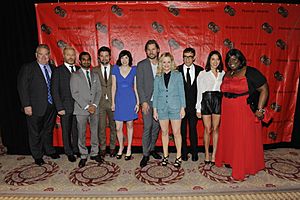
Grace Kelly and Prince Rainier III were regular guests. Elizabeth Taylor often visited the hotel for charity events. The hotel staff would prepare a lot for her visits.
Brooke Shields said her first time seeing paparazzi was at the Waldorf. She was 12 years old. She "debuted at the Waldorf." During her childhood, Paris Hilton lived with her family in the hotel.
The International Debutante Ball is a very fancy event. It is held every two years in the Grand Ballroom. Young women from important families around the world are introduced to society. The Lester Lanin Orchestra has traditionally played music at the ball since 1954.
|
See also
 In Spanish: Waldorf Astoria para niños
In Spanish: Waldorf Astoria para niños



